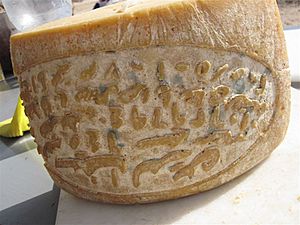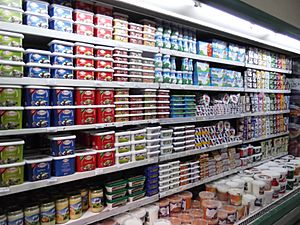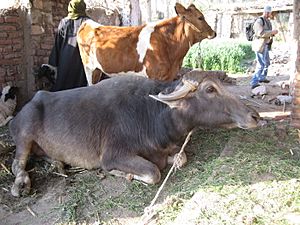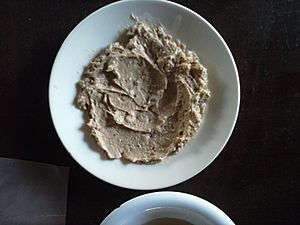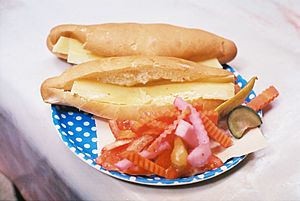Egyptian cheese facts for kids
Egyptian cheese is called gebna (pronounced GEB-na) in Arabic. It has been a very important food in Egypt for thousands of years. People in Egypt still eat a lot of cheese today.
We know that Egyptians were making cheese over 5,000 years ago, even during the time of the First Dynasty of Egypt. In the Middle Ages, the city of Damietta was well-known for its soft, white cheese. Egypt also bought cheese from other countries. For example, the popular hard yellow cheese called rumi gets its name from the Arabic word for "Roman."
Many people in the countryside still make their own cheese, like the special fermented mish. However, cheese made in large factories is now more common. Egyptians often eat cheese for breakfast. It is also used in many traditional dishes and even in some desserts.
Contents
History of Egyptian Cheese
Ancient Cheese Makers
Pictures on the walls of Egyptian tombs from 2,000 BC show how cheese was made. Scientists even found cheese inside two stone jars in a tomb at Saqqara. These jars were placed there around 3,000 BC, during the First Dynasty of Egypt. This cheese was probably a fresh type, made by adding acid or by heating the milk.
Another tomb, belonging to King Hor-Aha, might also have held cheese. The pots found there are similar to those used today to make mish. Ancient Egyptians made cottage cheese by shaking milk in a goatskin bag. Then, they would strain the thick part using mats made from reeds. You can see pieces of these old mats in the Museum of Ancient Egyptian Agriculture.
Around 300 BC, Egypt even imported cheese from the Greek island of Chios. There was a 25% tax on this imported cheese!
Cheese in the Middle Ages
A writer from the Middle Ages, Al-Isra'ili, described three kinds of cheese back then. There was a fresh, moist cheese eaten right away. There was also an old, dry cheese, which was often imported. And there was a "medium" cheese, which might have been preserved fresh cheese or something like Indian paneer.
During the Middle Ages, most Egyptian cheese was made from buffalo or cow's milk. Goat and sheep milk were used less often than in other countries nearby. The city of Damietta was the main place where cheese was made for the rest of Egypt. Damietta was famous for its buffaloes and special Khaysiyya cows, which were used to make Kaysi cheese. This cheese was mentioned as early as the 11th century AD.
A writer in the 15th century described Khaysi cheese being washed. This might mean it was put in salty water, like modern Dumyati cheese made in Damietta today. Fried cheese was also a popular food in medieval Egypt. Street sellers would cook it in oil and serve it with bread. Both rich and poor people ate it, and some kings even thought it was a special treat.
One writer in the 17th century described mishsh as a very strong, salty cheese. He said it was so sharp that it could "cut off the mouse's tail"! Farmers in Egypt ate this cheese with bread, leeks, or green onions as a main part of their meals. The mishsh eaten by country people today is very similar. Egyptians also bought cheese from Sicily, Crete, and Syria during the Middle Ages.
Modern Cheese Making
The amount of pickled cheeses made in Egypt grew a lot from 1981 to 2000. Almost all of this cheese was eaten in Egypt. In 1990, Egypt imported a lot of cheese, but after modern factories were built, imports dropped a lot by 2002.
Between 1984 and 2007, the total amount of cheese made in Egypt steadily increased. In 1991, about half of the cheese was still made by hand in villages. The other half was made using modern factory methods. The popular Domiati cheese was made by small private dairies and also in large government factories.
In 2000, people in Egypt ate about 4.4 kilograms (about 9.7 pounds) of pickled cheese per person each year. By 2002, more than one-third of all milk produced in Egypt was used to make traditional pickled cheeses or feta-like cheeses.
Today, domiati cheese uses less buffalo milk than it used to. Sometimes, vegetable oils are added instead of cow's milk fat to make it cheaper and keep its white color. Factories have also started heating the milk, but they try hard to keep the cheese tasting, feeling, and looking the same as people expect.
Egyptian Cheese in Meals
In Egypt, cheese is often served for breakfast with bread, jams, and olives. Different kinds of soft, white cheeses (called gebna bēḍa) and gebna rūmi are eaten in ēish fīno (a small baguette) or with ēish baladi (a flatbread). White cheeses and mish are also often served at the start of a meal with other appetizers and bread.
- Fiteer is a flaky pastry that can be filled or topped with white cheese and peppers, ground meat, egg, onions, and olives.
- Sambusak is another flaky pastry that can be stuffed with cheese, meat, or spinach.
Qatayef is a sweet dessert often eaten during the month of Ramadan. It started during the time of the Fatimid rulers. Street vendors in Egypt often make Qatayef. These are pancakes filled with nuts or soft cheese, then deep-fried and covered in sweet syrup.
Types of Egyptian Cheese
| English Name | Arabic Name | What it's like |
|---|---|---|
| Areesh | قريش | A soft, white cheese made from laban rayeb (a type of sour milk). |
| Baramily | براميلى | A white cheese that is aged in barrels. Its name means "barrel cheese." |
| Domiati | دمياطى | A soft white cheese, usually made from cow or buffalo milk. It's salted, heated, and then shaped. It can be eaten fresh or stored in salty liquid for many months. Domiati cheese makes up about three-quarters of all cheese made and eaten in Egypt. It's named after the city of Damietta and might have been made as early as 332 BC. |
| Halumi | حلومى | Similar to the Cypriot cheese halloumi, but a bit different. It can be eaten fresh or put in salty water with spices. The name comes from the old Coptic word for cheese, "halum." |
| Istanboly | اسطنبولى | A white cheese made from cow or buffalo milk, similar to feta cheese. |
| Mish | مش | A very strong and salty cheese made by letting cheese ferment for months in salty liquid. It's a very important food for farmers. Mish is often made at home from areesh cheese. |
| Rumi | رومى | A hard cheese that is ripened by bacteria. It's like cheeses such as Pecorino Romano and Manchego. It is salty, has a crumbly texture, and is sold at different stages of aging. |
See also
 In Spanish: Queso egipcio para niños
In Spanish: Queso egipcio para niños


